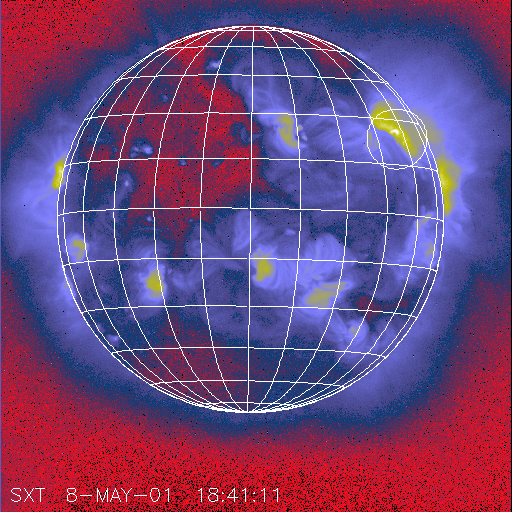
Last week we finally got untracked and executed our carefully-laid plans for a "Target Of Opportunity" (TOO) observing campaign, based upon the recognition of a new "sigmoid" coronal structure in the soft X-ray images. This required sending a message through Max Millennium, our information clearing-house for activity during the current solar sunspot maximum. The message announcing the discovery of the sigmoid went out on May 3. It incidentally coincided with a visit to ISAS by Dick Canfield, a guru of helicity as applied to the Sun, as is Alex Pevtsov, the author of the page just linked. Previous work has shown that the presence of bright S-shapes in X-ray images of the Sun anticipates eruptions. So our TOO has the purpose of orchestrating the response of many solar observers to catch the origins of an eruptive flare and CME. We were just lucky that Dick Canfield visited, shaping us up for this sometime ambiguous observational chore, and also shaping up the Sun so that it would cooperate. We chose NOAA active region 9445, as seen in this not-so-sigmoidal image from near its W limb passage:

The circle around the active region in the NE (upper right) shows where AR 9445 was on May 8, the day of a C9.9 flare - the day after the alert there had been an M-class eruptive flare, and two days later quite a striking CME occurred. All of this gladdens our hearts, we believers in the powers of a sigmoid!
We have made a list of flares in 9445
Some of these flares were not obviously CMEs in the SXT images. Our criteria for this would be the formation of a cusp or an arcade, or ideally the direct observation of things flying away from the site of the flare. An example is the M-class flare of May 8 (see the standard plot); below is a single frame from the SXT high-temperature Be filter:

Also there's a movie of this event:
shows clearly that this event is eruptive, but that the eruption is a confined eruption. In other words, the restructuring increases the size of the bright loops, but it only goes so far and does not "blow out." Interestingly, a CME did not appear to be associated directly with this flare, although region 9445 seemed to be pumping CMEs out with great abandon, almost as in a continual flow. If you have good bandwidth, please check out the beautiful SOHO/LASCO movie, noting especially the amazing N pole streamer blowout about 12 hours prior to this flare.
An eruption can be confined? This fuzzes out the distinction we thought we had clearly recognized between flares and CMEs on the one hand, and energy and helicity on the other. This maybe mythical pattern could be written in shorthand as
energy-buildup:flares::helicity-buildup:CMEs (see note if confused!)
which is strikingly hypothetical although neat and tidy.
In terms of theories, the morphology we see here has two contenders at least. Neither of them, of course, can determine quantitatively why any particular eruption would be confined or non-confined. One is the "tether-cutting" kind of reconnection, which involves only a single magnetic domain that is intrinsically unstable (e.g. Moore); another is the "separatrix" school of thought (e.g. Demoulin), in which multiple domains contend. Of course we hope that observations of the type recorded here will help to show both ideas wrong!
Our alert system for sigmoids worked this time, complementing our less-organized earlier efforts; please see the search facilities of these nuggets to learn more about our first go-around. Given that what we see here differs somewhat from what we saw before, we will have to conclude that one cannot have TOO many observations of sigmoids!
Note: We now maintain a topic index of the Yohkoh science nuggets.
May 11, 2001